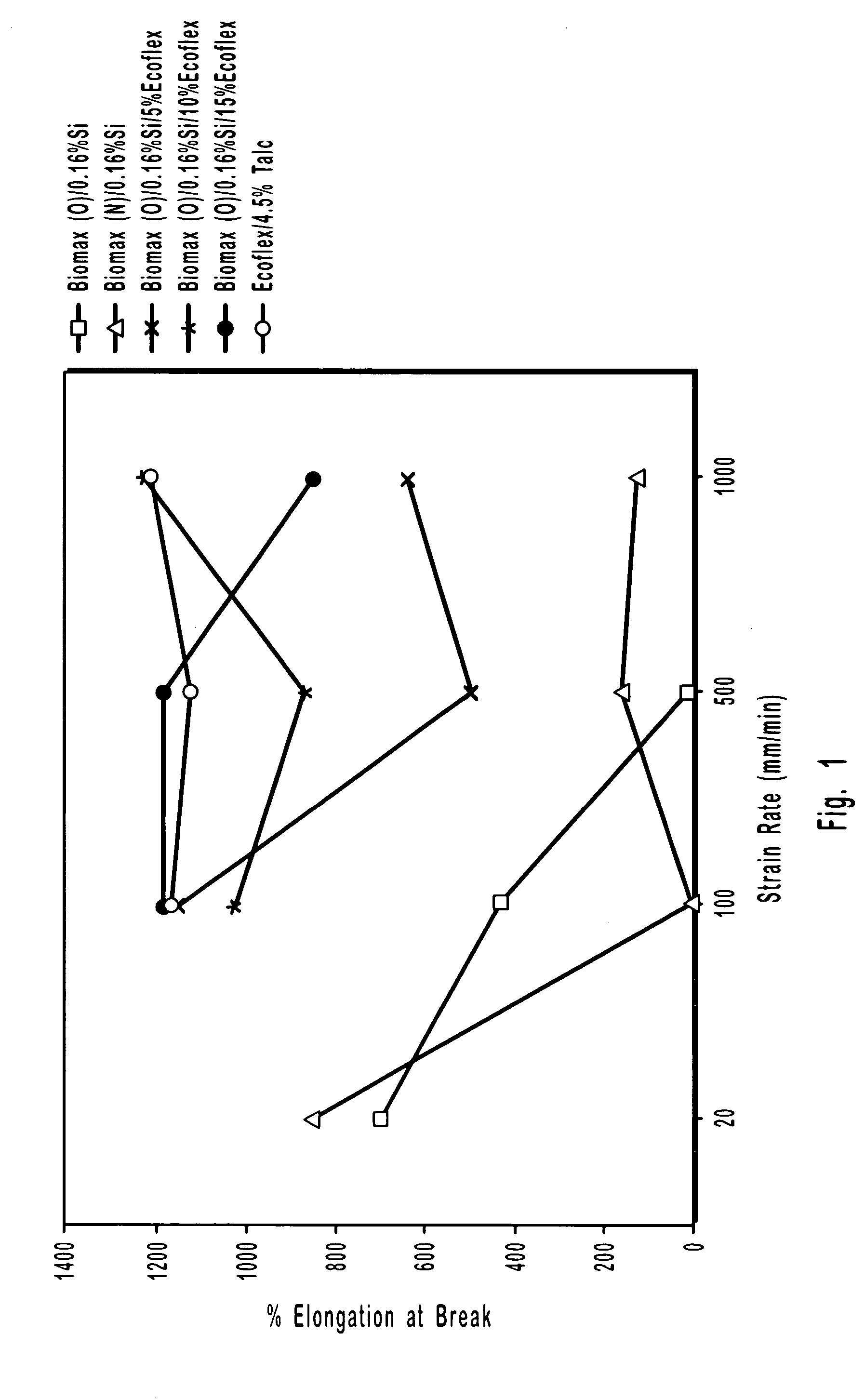Fibrous sheets coated or impregnated with biodegradable polyhydroxybutyrate polymers or polymer blends
a biodegradable polyhydroxybutyrate and fibrous sheet technology, applied in the field of fibrous sheet, can solve the problems of poor elongation or elasticity, biomax tends to be quite stiff or brittle when formed into films or sheets, and achieves easy spread or spraying, low melt flow index, and improved biodegradability.
- Summary
- Abstract
- Description
- Claims
- Application Information
AI Technical Summary
Benefits of technology
Problems solved by technology
Method used
Image
Examples
examples 1-3
[0184] Biodegradable polymer films were manufactured from biodegradable polymer blends having the following mix designs, with the concentrations being expressed in terms of weight percent of the entire polymer blend:
ExampleBiomax 6926Ecoflex-FSiO2194.84% 5%0.16%289.84%10%0.16%379.84%20%0.16%
[0185] The foregoing polymer blends were blended and blown into films at Gemini Plastics, located in Maywood, Calif., using DuPont supplied BIOMAX 6926 (both new and old lots), a silica master batch in BIOMAX 6926 base resin supplied by DuPont, and ECOFLEX-F resin obtained from BASF. The films were blown using a Gemini film blowing extruder (L / D 24 / 1) equipped with a 2 inch barrier mixing screw containing a Maddock shear mixing tip, and a 4 inch diameter annular die with a die gap of 0.032-0.035″.
[0186] Even though a typical quantity of silica antiblock was used (i.e., 0.16%), significant blocking of the film was observed for the film made using the mix design of Example 3 (i.e. 20% ECOFLEX); ...
examples 4-5
[0196] Films were manufactured from biodegradable polymer blends having the following mix designs, with the concentrations being expressed in terms of weight percent of the entire polymer blends:
ExampleBiomax 6926Ecoflex-FTalc479.7%16.7%3.6%576.7%16.7%6.6%
[0197] The films were blown using a Gemini film blowing extruder (L / D 24 / 1) equipped with a 2 inch barrier mixing screw containing a Maddock shear mixing tip, and a 4 inch diameter annular die with a die gap of 0.032-0.035″. The film of Example 5 had better dead-fold properties than the film of Example 4, which might be attributable to the higher concentration of talc within the blend used in Example 5.
[0198] The foregoing films are used to laminate at least one side of a fibrous sheet, such as a tissue paper, more particularly a 12-15 lb / 3000 ft2 tissue paper, to yield a treated sheet. The treated sheet can be used as a food packaging wrap that resist penetration by water and oils found in food.
example 6
[0199] A film was manufactured from a biodegradable polymer blend having the following mix design, with the concentration being expressed in terms of weight percent of the entire polymer blend:
ECOFLEX-F20%Thermoplastic Starch50%Polylactic Acid15%Inorganic Filler15%
[0200] The Thermoplastic Starch was obtained from Biotec Biologische Natuverpackungen GmbH & Co., KG (“Biotec”), located in Emmerich, Germany. The polylactic acid was obtained from Cargill-Dow Polymers, LLC, located in Midland, Mich., USA. The inorganic filler was calcium carbonate obtained from OMYA, division Pluess-Staufer AG, located in Oftringen, Switzerland.
[0201] The foregoing blend was manufactured and blown into films using a proprietary extrusion line thermoplastic starch extrusion / film blowing apparatus manufactured and assembled specifically for Biotec. In particular, the extrusion / film blowing apparatus was manufactured by Dr. Collin GmbH, located in Ebersberg, Germany. A detailed description of an extrusion...
PUM
| Property | Measurement | Unit |
|---|---|---|
| glass transition temperature | aaaaa | aaaaa |
| glass transition temperature | aaaaa | aaaaa |
| glass transition temperature | aaaaa | aaaaa |
Abstract
Description
Claims
Application Information
 Login to View More
Login to View More - R&D
- Intellectual Property
- Life Sciences
- Materials
- Tech Scout
- Unparalleled Data Quality
- Higher Quality Content
- 60% Fewer Hallucinations
Browse by: Latest US Patents, China's latest patents, Technical Efficacy Thesaurus, Application Domain, Technology Topic, Popular Technical Reports.
© 2025 PatSnap. All rights reserved.Legal|Privacy policy|Modern Slavery Act Transparency Statement|Sitemap|About US| Contact US: help@patsnap.com



